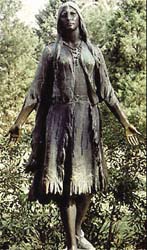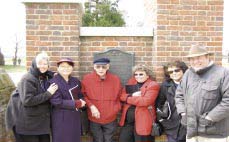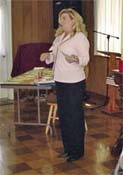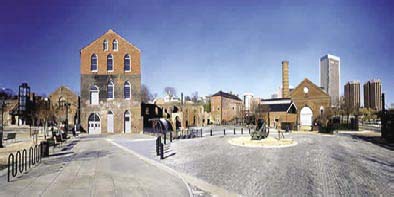HCHS President's Message - June, 2007

The statue of Pocohontas on the left, designed by William Ordway Partridge, was erected in Historic Jamestowne in 1922.
Never before do I recall the interest in history that the 400 year Anniversary of the settlement in Jamestown has initiated. We are experiencing today the history of tomorrow. Queen Elizabeth II spoke at the General Assembly and with Prince Phillip toured the grounds of the newly renovated Capital Building. In her speech, the queen referred to the cultural diversity of this great nation that sets an example for social challenges experienced world-wide. The amazing story of three interacting civilizations, Western European, Native American, and African, represents the success of the Jamestown settlement.
I recently had the pleasure of representing HCHS at a reunion of several families that traced their ancestry to Henrico and Goochland Counties; some lived nearby and others came long distances to meet their long lost cousins. Interestingly enough, one of their ancestors, David Ellis arrived in Jamestown in 1609. It is a challenge at times to trace one’s ancestry which prompted an article on genealogical DNA testing now available to those researching their families.
Our June meeting at the American Civil War Center also represents social diversity in that it tells the story of the American Civil War from three perspectives, Union, Confederate, and African-American. It is through the understanding of these separate perspectives that we comprehend the profound impact of the event, second only to the Revolutionary War, which threatened the future of the entire nation.
We hope you can join us there.
Sarah Pace
President
>Back to Top<
Jamestown Trip - June, 2007

Our March 4th trip to Jamestown was a hugh success with 53 attending. It was a little brisk that day but the sun was shining and a good time was had by all. We had a wonderful tour provided by the National Park Service and were facinated by the artifacts on display at the new visitors center and Archaearium Building.
We hope to have other trips of historical interest in the future. If you have suggestions for future trips, please let us know.
>Back to Top<
HCHS Calendar for 2008 - June, 2007
Planning has begun for creating a 2008 Calendar for the Henrico County Historical Society, which will be for sale by December of 2007.
We are in the process of collecting photos or images reflecting history in Henrico County. If you have suggestions or photos you would like to submit for this project, please contact: Vicki Stephens arnim@westhanover.net or (804)227-3673.
>Back to Top<
Matching Gift - June, 2007
The Henrico County Historical Society will present a matching gift in cooperation with County of Henrico, Division of Recreation and Parks. A watercolor painting of the manor house at Curles Neck was purchased and will become an addition to the Henrico County collection.
The painting will be on display at the Annual meeting on June 3rd.
>Back to Top<

Welford Williams, after being inducted April 14, 1943, with active duty beginning on April 21st, served in the 3393 Quarter Master Truck Company of the U.S. Army during World War II. First arriving at Liverpool, England on May 18, 1944, his unit landed on Omaha Beach (Normandy) July 6, 1944. By wars end his outfit had been in many areas of France, Belgium and the Country of Luxembourg.
Mr. Williams wrote, “Who could ever forget the German Buzz-bombs that hit so close to areas we traveled and rested.” During his service he guarded prisoners and drove on the Red Ball Express (convoy) supplying troops. Mr. Williams describes the Red Ball Express as having a direct road to the troops in order to get supplies to the lines in a hurry when needed. One of his wartime experiences involved flipping one of the vehicles used to deliver supplies.
Upon discharge, Dec. 26, 1945, he had earned the American Theater Service Medal with 5 bronze stars; Victory and Good Conduct Medals. He was also awarded a Drivers Badge and Marksmanship on weapons: 03,M1, carbine, hand grenade, bazooka, and 30 caliber machine gun.
After the war Mr. Williams married Willie Mae Love and had a family of 8 children. He retired from the US Postal Service, and in later years worked as a guard at the Henrico County Government Center. Mr. Williams currently serves as Director of the Fairfield District for the Henrico County Historical Society.
>Back to Top<
The History of the Bronze Start Medal - June, 2007
(Reprinted in part from Wikipedia Website)

The Bronze Star Medal is a United States Armed Forces individual military decoration which may be awarded for bravery, acts of merit, or meritorious service. When awarded for bravery, it is the fourth-highest combat award of the U.S. Armed Forces and the 9th highest military award (including both combat and non combat awards) in the order of precedence of U.S. military decorations. (Note: When awarded for valor it is accompanied with an attached V. When awarded for meritorious service it does not have the valor component.)
The award that eventually became the Bronze Star Medal was conceived by Colonel Russel P. “Red” Reeder in 1943, who believed it would aid morale if there was a medal which could be awarded by captains of companies or batteries to deserving people serving under them. Reeder felt the medal should be a ground equivalent of the Air Medal, and proposed that the new award be called the “Ground Medal”.
The idea eventually rose through the military bureaucracy and gained supporters. General George C. Marshall, in a memorandum to President Franklin D. Roosevelt dated 3 February 1944, wrote, “The fact that the ground troops, Infantry in particular, lead miserable lives of extreme discomfort and are the ones who must close in personal combat with the enemy, makes the maintenance of their morale of great importance. The award of the Air Medal have had an adverse reaction on the ground troops, particularly the Infantry Riflemen who are now suffering the heaviest losses, air or ground, in the Army, and enduring the greatest hardships.”
The Air Medal had been adopted two years earlier to raise airmen's morale. President Roosevelt authorized the Bronze Star Medal by Executive Order 9419 dated 4 February 1944, retroactive to 7 December 1941. This authorization was announced in War Department Bulletin No. 3, dated 10 February 1944.
>Back to Top<
Family Reunion - June, 2007
A reunion was recently held in the Fellowship Hall of Deep Run Baptist Church, a historical landmark in Henrico County where Shari Eichler’s great-great-great grandparents were married.

This event presented an opportunity for the related members of the Ellis, Smoot, Seay, Alley, Utley and Cooley families to meet; some lived nearby and some had traveled long distances. Their connections had been interesting. Shari Eichler (pictured at left), who resides in Texas, initiated the search for her ancestors as a gift to her father after his beach house had been destroyed by a hurricane. Shari began her research over the internet and before long had been in contact with some ofher long lost cousins and made the connection to Henrico and Goochland Counties where some of her ancestors had worked in coal mines. In 2006, she and her father traveled to the area, visiting court houses, libraries, andcemeteries, making connections along the way. Phyllis Silber, Executive Director of the Goochland Historical Society, assisted in the research. They discovered that a number of their ancestors were buried in St.Mary’s Episcopal Church on River Road. Eventually their ancestry was traced to David Ellis, who arrived in Jamestown in 1608.
Patty Kruszewski wrote an article in the Henrico Citizen about Shari’s experiences in November of 2006.
Shari decided it was time for everyone connected with this project to finally meet and planned the reunion for May 2nd of this year. Close to 50 people attended, each bringing their own information to share. One person said she had not known where her grandparents had been buried until now. Another relative, Ed Robson, spoke on his experience with genealogical DNA testing, which is a relatively new tool for researching ancestry. And so they came; from Texas; Ohio; North Carolina; from Chesterfield County; from Powhatan County; from Goochland as well as Henrico County to celebrate the lives, past and present, of their family.
>Back to Top<
Genealogical DNA Test - June, 2007
A genealogical DNA test examines the nucleotides at specificlocations on a person’s DNA for genetic genealogy purposes. The test results are meant to have no informative medical value and do not determine specific genetic diseases or disorders; they are intended only to give genealogical information. Genealogical DNA tests generally involve comparing the results of living individuals as opposed to obtaining samples from deceased people.
The general procedure for taking a genealogical DNA testinvolves taking a painless cheek-scraping (swab) at home and mailing the sample to a genetic genealogy laboratory for testing. Some laboratories use mouth wash or chewing gum instead of cheek swabs. Some laboratories offer to store DNA samples for ease of future testing. All United States laboratories will destroy the DNA sample upon request by the customer, guaranteeing that a sample is not available for further analysis. The most popular ancestry tests are Y chromosome (Y-DNA) testing and mitochondrial DNA (mtDNA) testing. Other tests attempt to determine a researcher’s comprehensive genetic history and/or ethnic origins.
A man’s paternal ancestry can be traced using the DNA on his Y chromosome (Y-DNA). This is useful because the Y chromosome, like many European surnames, passes from father to son, and can be used to help study surnames. Women who wish to determine their paternal ancestry can ask their father,brother, paternal uncle, paternal grandfather, or a cousin who shares the same paternal lineage to take a test for them (i.e. any male family member who has the same surname as her father).
A person’s maternal ancestry can be traced using his or her Mitochondrial DNA (mtDNA). The DNA in the human mitochondria is passed down by the mother unchanged. One exception, which was linked to infertility, has been shown. Additionally, some people cite paternal mtDNA transmission as invalidating mtDNA testing, but this is generally disregarded in genetic genealogy as not problematic.
(Reprinted from Wikipedia website)
Autosomal tests look at genetic markers on all chromosomes and provide an approximate breakdown of Native American, African, Asian and European ancestry. The tests cost from $95 to $399 (depending on the number of markers tested). Specialized tests that offer detailed information on ethnic origins tend to be the most expensive. Ethnic and racial identities are determined by probability and are not 100% certain. Most companies provide information on margins of error.
Kits ordered online typically includes a cotton swab, used to swipe a cell sample from inside a cheek (or any other method of collecting a sample), plus a vial or an envelope for mailing. Results usually arrive by mail or online in four to six weeks.
Tests may be ordered from any one of the following:
The following databases allow you to compare genetic markers to find living relatives or identify common ancestors:
(source: Time Magazine)
>Back to Top<
Announcement: The Third Walker Family Reunion - June, 2007
Submitted by Marie Walker Jennings:
The 3rd Walker Family Reunion is planned for descendants of William Walker (ca 1655-1723) and Elizabeth Warren, David Walker (1699-1774 and Mary of Goochland Co. and Rev. William Walker (1717-??)and Jane Bayes. The event will be held in Williamsburg, VA, September 6-8th, 2007. These three Walker men were found to be related through DNA testing by the Walker Surname DNA Project. There are several other Walker men in the DNA project who are also related to this large extended family: Phillip of Goochland Co., Elijah of Georgia, Peter of NC, Jacob and Blackstock of NC/SC. Records of these Walkers have been found in York, New Kent, Charles City, Henrico, and the surrounding counties of Goochland, especially Fluvanna, Louisa, Cumberland, Hanover, and Albemarle, Virginia.
All descendants of these Walker families are invited to attend the reunion. Pedigrees of the DNA participants can be found on the Walker DNA Project Website in Group 2. For information about the families included and for details of the reunion you can contact: Marie Jennings Mwj819@aol.com or Barbara Good BWGood@aol.com or call Barbara at(954)763-2861.
>Back to Top<
Genealogical Inquiry, June 2007
Looking for anyone researching the Childress, Gill or Garthright families that lived around Darbytown and Charles City Road area. Alexander Childress was married to Elizabeth Warriner and later to Temperence Bennett. He was a Mattross in the Rev. War. Also looking for info on Festus Gill and Cordelia Garthwright Gill. He was in the Civil War and is buried at Hardy Central on Darbytown Road. These Families connect in many different ways. Looking for anyone doing research on Edmund W. Allen who was a doctor in Henrico County, VA. Several members of the Allen Family lived in Henrico County in the 1700-1800’s.
Please contact Marie Walker Jennings at atmwj819@aol.com or (804)746-4970.
>Back to Top<
June 2007 Second Quarterly Meeting
The Annual meeting of the Henrico County Historical Society will start at 1:00 on Sunday, June 3rd with an optional brunch at the Tobacco Company Restaurant on the corner of Cary Street at 12th Street in Shockoe Slip. We will be dining on the 3rd floor which can be reached by elevator if necessary. Ample parking for the Tobacco Company is available in the parking deck on 12th Street right behind the restaurant. Cost for parking is only $1.00 for up to 2 hours. Total cost of brunch is $15.95 (including tax and gratuity) and will consist of a choice of:
- Eggs Benedict
- Cherries Jubilee French Toast
- Southern Breakfast Platter
- Grilled Chicken & Spinach Salad
- All American Burger
- Ham & Cheese Crepes
- Chicken Caesar Salad
Those who do not desire to have brunch should plan to meet at the American Civil War Center at Historic Tredegar at approximately 2:30 p.m., for the business meeting and group tour of the Center. The Center is located at 490 Tredegar Street downtown on a beautiful 8-acre National Historic Landmark site on Richmond's James River.
During our business meeting, there will be an election of officers and a vote regarding By-Law changes. Officers will be elected to serve for a term of two years from June 2007 through June 2009. The Directors of the Brookland District and the Tuckahoe District will be elected for a three year term from June 2007 through June 2010.
- All current officers have been nominated by committee to serve for another term.
- Ruth Anne Kramer has been nominated for Director of the Tuckahoe District.
- Allan Wagner, III has been nominated for Director of the Brookland District.
We would like to take this opportunity to thank Buddy and Betty Harlan for many years of service representing the Tuckahoe District and to Elizabeth Lowry for many years of service representing the Brookland District.
We will be taking a vote on several HCHS By-Law changes as well. Please bring the printed copy of proposed By-Law changes, found as an insert in the last newsletter, to the meeting in order to follow the discussion.
American Civil War Center at Historic Tredegar has 5 surviving buildings that illustrate the ironworks era. Our tour will begin with a film titled, "What Caused the Civil War?" The exhibit presents the story of the Civil War, its causes, and its legacies from the viewpoints of Unionists, Confederates, and African Americans. The group tour fee is $4.00 per person.
|
If you plan to attend the brunch and/or the Civil War Center, please RSVP to Linda Dickerson no later than May 25th by calling (H) 364-3492 or by emailing: ldickerson@oag.state.va.us. Those replying after May 25th may not be assured of getting a brunch reservation.
|

Tredegar was founded in 1836 by Francis B. Deane and named it for a Welsh town and ironworks. By 1847, Tredegar had U.S. government contracts for cannons and also manufactured, among other things, locomotives, train wheels, ships' boilers and naval hardward. During the Civil War, Tredegar manufactured armor plates for the ironclad CSS Virginia (formerly USS Merrimack), but specilized in cannons. Tredegar later cast munitions for the U.S. Army and Navy during the Spanish-American War, World Wars I and II, and the Korean War. Ethyl Corporation bought the ironworks site in 1957 and restored the surviving buildings in the 1970s.
Directions from Tobacco Company to the American Civil War Center:
- When you leave the Tobacco Company, head west on Main Street or Canal Street.
- Turn left onto South 5th Street.
- Go to end of street and turn right onto Tredegar St.
- Turn right into parking lot at Richmond Civil War Visitor Center sign.
Directions Straight to the American Civil War Center:
- From the West:
- From Interstate 64, take Interstate 195 to the Downtown Expressway.
- Take the Downtown Expressway through toll plaza (50 cents).
- Get off the expressway at Byrd Street/2nd St. exit & go straight.
- Turn right on S. 5th St.
- Go to end of street and turn right onto Tredegar St.
- Turn right into parking lot at Richmond Civil War Visitor Center sign.
- From the East:
- Take Interestate 64 West to Richmond.
- Get onto Interstate 95 South.
- Take the Downtown Expressway exit 74A.
- Take the first exit, Canal Street (20 cents).
- Turn left onto S. 5th St.
- Go to the end of the street and turn right onto Tredegar St.
- Turn right into parking lot at Richmond Civil War Visitor Center sign.
- From the North:
- Get on Interstate 95 South.
- Take the Downtown Expressway exit 74A.
- Take the first exit, Canal Street (20 cents).
- Turn left onto S. 5th St.
- Go to the end of the street and turn right onto Tredegar St.
- Turn right into parking lot at Richmond Civil War Visitor Center sign.
- From the South on Powhite Parkway:
- After crossing the river, take the Downtown Expressway exit on the right into town.
- Go through the toll plaza (50 cents).
- Get off the expressway at Byrd Street/2nd St. exit & go straight.
- Turn right on S. 5th St.
- Go to end of street and turn right on to Tredegar St.
- Turn right into parking lot at Richmond Civil War Visitor Center sign.
- From the South on Interstate 95:
- As you cross the river, get in the right-hand lane and take the Downtown Expressway exit 74A.
- Take the first exit, Canal Street (20 cents).
- Turn left onto S. 5th St.
- Go to the end of the street and turn right onto Tredegar St.
- Turn right into parking lot at Richmond Civil War Visitor Center sign.
>Back to Top<
News 2007: Second Quarter
First Quarter | Third Quarter | Fourth Quarter
Home | Henrico | Maps | Genealogy | Preservation | Membership | Shopping | HCHS
|












